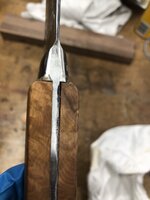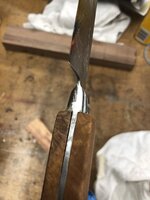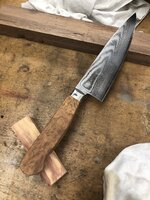You are using an out of date browser. It may not display this or other websites correctly.
You should upgrade or use an alternative browser.
You should upgrade or use an alternative browser.
Scale falling off tang...Knife help.
- Thread starter wrjones224
- Start date
Signed-In Members Don't See This Ad
See more from wrjones224
Signed-In Members Don't See This Ad
444
Member
I would clean it all up and give the knife handle (the metal) a rough finish and use JB weld.
I've only done about less than a dozen. What I think I see is the blade handle or the scale was not flat all the way across. You could try to fill it, but without knowing how much of it separated under the scale, could cause a problem down the road. It looks like the space goes a pretty good ways down. You haven't drilled it for pins yet so if it were me, I'd try to pry it back off and get everything flat. You may be able to drip some acetone in between the wood and the blade and that will help loosen up the epoxy.
carlmorrell
Member
I made a few knives last year. I had some issues with the scales, I was bleaching wenge and had some really bad outcomes. I was very surprised how easy it was to remove the scales. I put the knife in boiling water for a few minutes. That weakened the epoxy, and they came off very easily. Considering you did not use pins, it should be very easy to remove them. I would then clean up the metal, mechanically and then with denatured alcohol. You can then re-glue them. Clamp it, but not too tight. I would also suggest using the pins. It makes the knife look more finished, and I think they are supposed to help keep the scales on.
![20210331_184134[1].jpg 20210331_184134[1].jpg](https://www.penturners.org/attachments/20210331_184134-1-jpg.303134/)
wolf creek knives
Member
Here's how I do my scales on all my knives. After close to 300 I've had only two failures and that was done by the owner abusing the knife. Plus these were not pinned on as the buyer didn't want them pinned.
1. Take your dremel tool and rough up the handles on both sides.
2. After the rough up, I use Acetone to remove any shavings or any kind of junk still on the handle (stickers, rust etc.)
3. I Epoxy each side individually. Day one, one side gets glued on the handle and clamped. I also do not precut my scales to the design of the handle, they are well over sized to the handle material. Day two I carefully cut the scale off from day one on my band saw, cut proud of the handle and then I drill my holes in for the pins and then Epoxy the second scale on, clamp it and day two remove it the same way you did the first scale. I use System Three T-88 Epoxy and it works great.
4. After drilling the proper size pin hole in the other side I then "form" the scales to the desired design. One of the things I noticed in your pictures was that you didn't take the scales down even with the bolsters. I use a Micro-plane to remove that area after taping the bolster off. With Damascus you have to be very careful so a lot of tape on the bolsters helps.
5. Pins are Epoxied in place and I also, very, very carefully, peen with a ballpeen hammer just enough to snug the pins against the scales. Too much peening and you'll crack the scales. You shouldn't peen mosaic pins or threaded pins on a folding knife!
6. Let the Epoxy set overnight and the next day I use a file to file down the pins even with the scales.
I start with 150 grit sandpaper for final shaping and then start working my way down until I get to 800 grit. Then I apply my finish. Just a note, plan on using quite a bit of sandpaper to finish your scales.
Here's some pictures of a knife I'm working on right now. Hope this helps and makes sense. Best of luck and reach out if I can help.
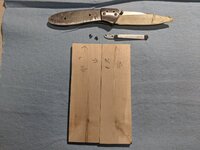
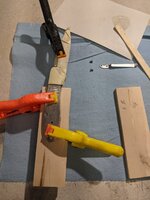
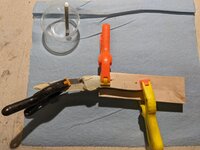
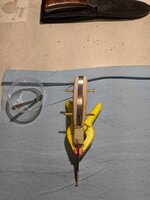
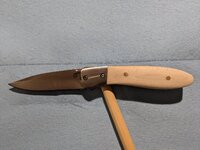
1. Take your dremel tool and rough up the handles on both sides.
2. After the rough up, I use Acetone to remove any shavings or any kind of junk still on the handle (stickers, rust etc.)
3. I Epoxy each side individually. Day one, one side gets glued on the handle and clamped. I also do not precut my scales to the design of the handle, they are well over sized to the handle material. Day two I carefully cut the scale off from day one on my band saw, cut proud of the handle and then I drill my holes in for the pins and then Epoxy the second scale on, clamp it and day two remove it the same way you did the first scale. I use System Three T-88 Epoxy and it works great.
4. After drilling the proper size pin hole in the other side I then "form" the scales to the desired design. One of the things I noticed in your pictures was that you didn't take the scales down even with the bolsters. I use a Micro-plane to remove that area after taping the bolster off. With Damascus you have to be very careful so a lot of tape on the bolsters helps.
5. Pins are Epoxied in place and I also, very, very carefully, peen with a ballpeen hammer just enough to snug the pins against the scales. Too much peening and you'll crack the scales. You shouldn't peen mosaic pins or threaded pins on a folding knife!
6. Let the Epoxy set overnight and the next day I use a file to file down the pins even with the scales.
I start with 150 grit sandpaper for final shaping and then start working my way down until I get to 800 grit. Then I apply my finish. Just a note, plan on using quite a bit of sandpaper to finish your scales.
Here's some pictures of a knife I'm working on right now. Hope this helps and makes sense. Best of luck and reach out if I can help.





Last edited:
LK&T
Member
Don't try and clamp that down. Whether you get the scales off and reuse them or start over with new scales, you should fit the scales better before epoxying them to the tang. The epoxied side of the scales should fit flush to the tang. Using clamps to bend/twist the scales flush to the tang causes a lot of stress in the wood and that'll cause problems down the road with cracking and breaking.

